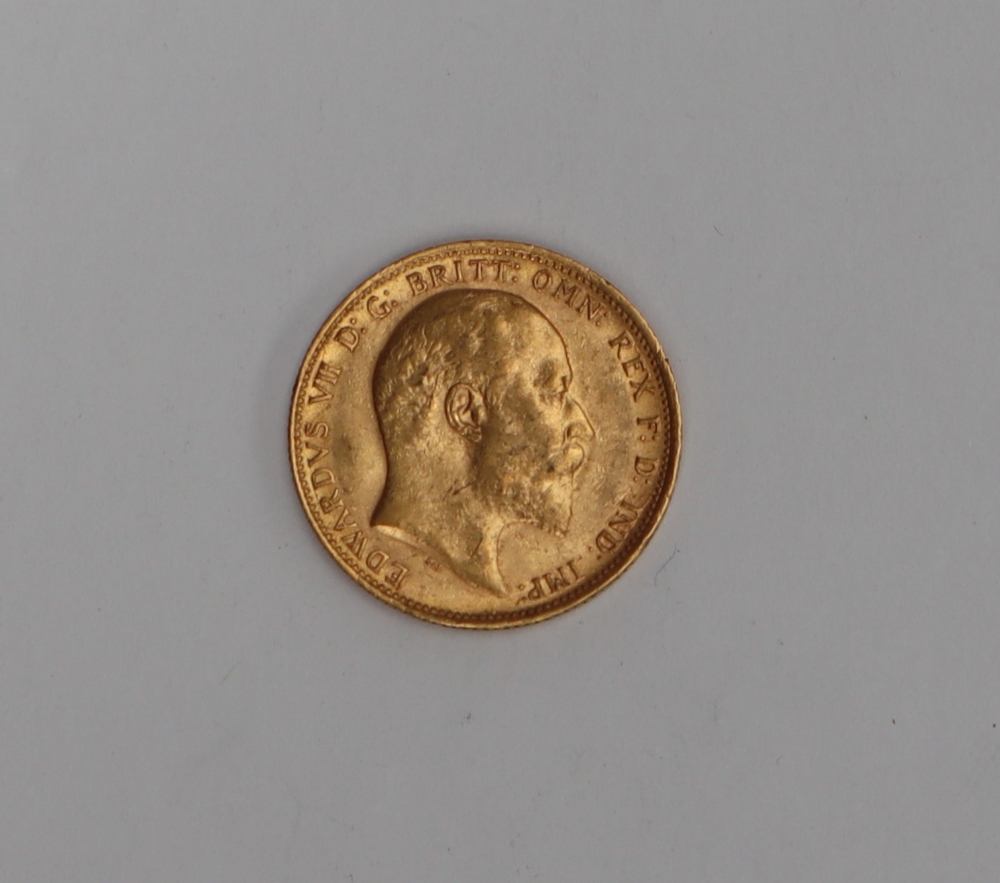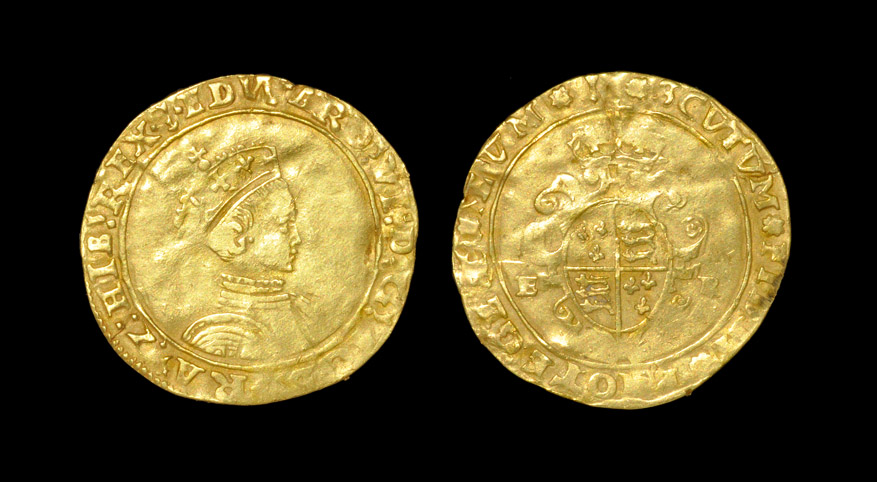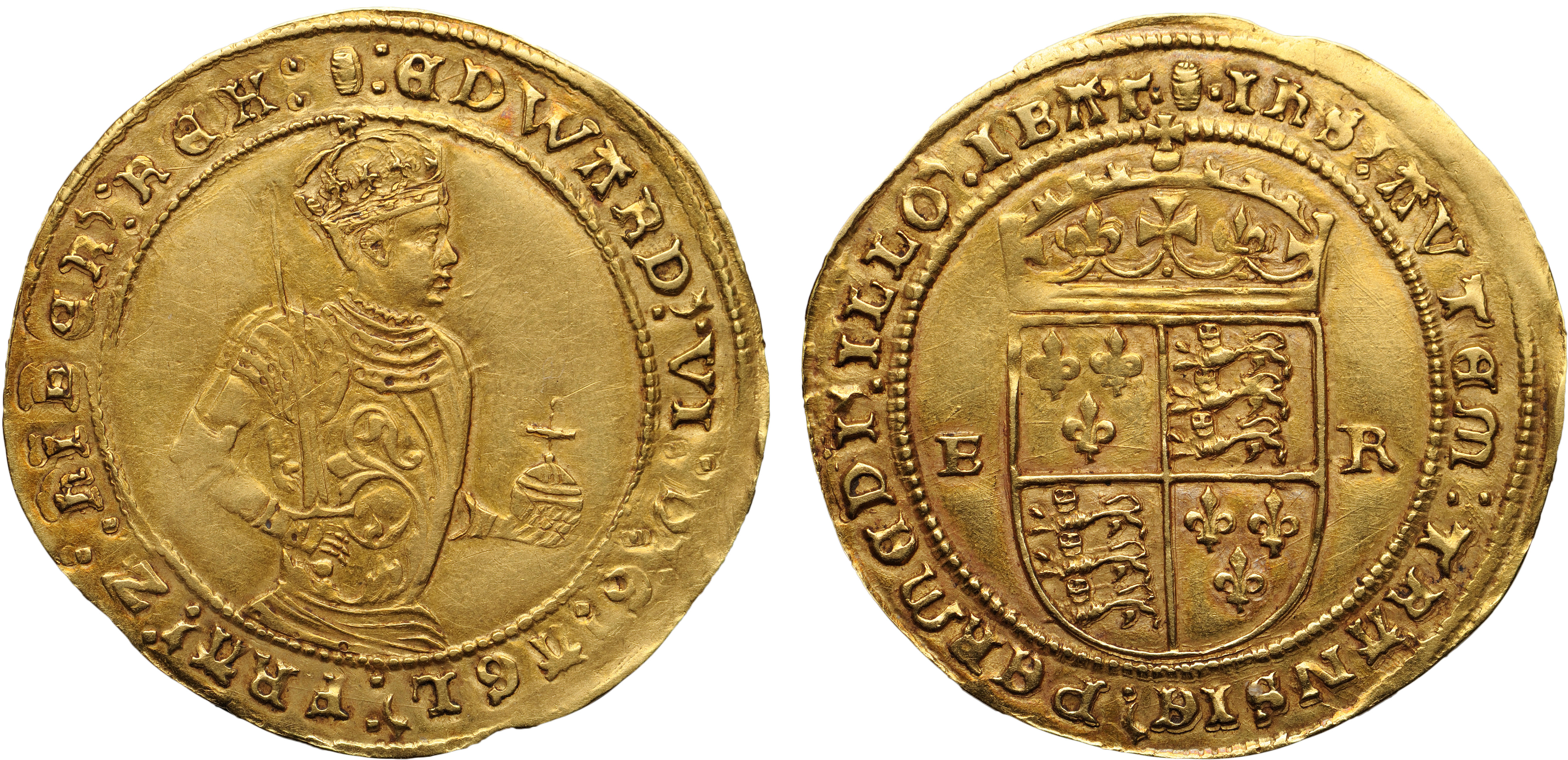S-2433, 10.97 grams, 36mm. Second period (1549-1550), Mintmark Y, King seated facing on throne holding orb and sword, reads EDWARD. VI. DEI. GRA. AGL. FRAN. ET. HIBER. REX, REVERSE: crowned shield with supporters and ER in cartouche below, reads IHS AVTE TRANSIENS PER MIDIV LLORV IBAT, small square stops. Well centered on a full flan and nicely struck for this issue, although because of a variation in the thickness of the flan, it is weakly struck in the middle. Free from other flaws and defects. An unusually strong portrait of the boy-king. Light, attractive green-golden tone with subtle reddish accents as the coin turns under a light. One of the finer pieces on the world market in recent years. The sovereign as a denomination was introduced during the reign of Henry VII (1485-1509), and as Sutherland points out it was "deliberately so called to reflect the splendor of a great gold coin of 240 grains--twice the ryal--and worth 20 shillings." The coin was first conceived by order of a special commission of 1489, and its engraver was Alexander of Brugsal, a German appointed in 1494 to the Royal Mint. The coin was the most elaborate ever made of gold in the British Isles, and the first tentative issues, those of both Henry VII and Henry VIII, are extremely rare. Edward VI, of course, was Henry VIII's son by Jane Seymour born in 1537 and not quite ten years of age when his father passed away leaving the kingdom to him. As a child he did not rule in fact, but was influenced to make decisions by his Council and in particular by a succession of relatives--first his uncle Edward Seymour (Duke of Somerset), next by the Duke of Northumberland. Each sought to jockey his family into positions of power at court. The young king's diary tells us how he despised both of them and how he watched compromised advisors executed with cool detachment. When he died of tuberculosis at age 15, another succession of executions of royal hopefuls (including that of Northumberland's daughter-in-law, Lady Jane Gray, the king's cousin) ended in England's relapse into religious war under Mary Tudor, Henry VIII's eldest daughter, born of a Catholic mother. She rebuffed Protestant suitors and married her cousin, Philip, prince of Spain, at Winchester in 1554. He brought the idea of Inquisition to England. Nightmarish "witch hunts" of Protestants left a terrible scar on the land, but only for a short time, because Mary died of stomach cancer in 1558. Her husband had used her solely to declare war on France, which ended in disaster, the loss of Calais after two centuries of possessing it as "English territory." Upon Mary's death, Philip quickly returned to Spain, to become enemy of the new queen, Mary's younger sister Elizabeth, daughter of Anne Boleyn. Thirty years later, he would send the Armada to defeat her, but the upset battle instead ended centuries of Spain's might on the high seas, and ushered in a long era of naval glory for England. Mary Tudor's coins are all rare, her portrait on them appropriately stark, her gold sovereign a continuation of the superb line begun by her grandfather, and given true elegance during her short reign, when it was first called a "fine sovereign," reflecting an increase of its value from 20 to 30 shillings. Ironically, in later years, the English sovereign was frequently coined from gold seized in warfare from Spain. Extremely Fine or better
S-2433, 10.97 grams, 36mm. Second period (1549-1550), Mintmark Y, King seated facing on throne holding orb and sword, reads EDWARD. VI. DEI. GRA. AGL. FRAN. ET. HIBER. REX, REVERSE: crowned shield with supporters and ER in cartouche below, reads IHS AVTE TRANSIENS PER MIDIV LLORV IBAT, small square stops. Well centered on a full flan and nicely struck for this issue, although because of a variation in the thickness of the flan, it is weakly struck in the middle. Free from other flaws and defects. An unusually strong portrait of the boy-king. Light, attractive green-golden tone with subtle reddish accents as the coin turns under a light. One of the finer pieces on the world market in recent years. The sovereign as a denomination was introduced during the reign of Henry VII (1485-1509), and as Sutherland points out it was "deliberately so called to reflect the splendor of a great gold coin of 240 grains--twice the ryal--and worth 20 shillings." The coin was first conceived by order of a special commission of 1489, and its engraver was Alexander of Brugsal, a German appointed in 1494 to the Royal Mint. The coin was the most elaborate ever made of gold in the British Isles, and the first tentative issues, those of both Henry VII and Henry VIII, are extremely rare. Edward VI, of course, was Henry VIII's son by Jane Seymour born in 1537 and not quite ten years of age when his father passed away leaving the kingdom to him. As a child he did not rule in fact, but was influenced to make decisions by his Council and in particular by a succession of relatives--first his uncle Edward Seymour (Duke of Somerset), next by the Duke of Northumberland. Each sought to jockey his family into positions of power at court. The young king's diary tells us how he despised both of them and how he watched compromised advisors executed with cool detachment. When he died of tuberculosis at age 15, another succession of executions of royal hopefuls (including that of Northumberland's daughter-in-law, Lady Jane Gray, the king's cousin) ended in England's relapse into religious war under Mary Tudor, Henry VIII's eldest daughter, born of a Catholic mother. She rebuffed Protestant suitors and married her cousin, Philip, prince of Spain, at Winchester in 1554. He brought the idea of Inquisition to England. Nightmarish "witch hunts" of Protestants left a terrible scar on the land, but only for a short time, because Mary died of stomach cancer in 1558. Her husband had used her solely to declare war on France, which ended in disaster, the loss of Calais after two centuries of possessing it as "English territory." Upon Mary's death, Philip quickly returned to Spain, to become enemy of the new queen, Mary's younger sister Elizabeth, daughter of Anne Boleyn. Thirty years later, he would send the Armada to defeat her, but the upset battle instead ended centuries of Spain's might on the high seas, and ushered in a long era of naval glory for England. Mary Tudor's coins are all rare, her portrait on them appropriately stark, her gold sovereign a continuation of the superb line begun by her grandfather, and given true elegance during her short reign, when it was first called a "fine sovereign," reflecting an increase of its value from 20 to 30 shillings. Ironically, in later years, the English sovereign was frequently coined from gold seized in warfare from Spain. Extremely Fine or better















Try LotSearch and its premium features for 7 days - without any costs!
Be notified automatically about new items in upcoming auctions.
Create an alert